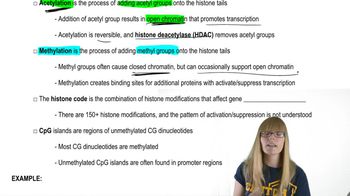Table of contents
- 1. Introduction to Genetics51m
- 2. Mendel's Laws of Inheritance3h 37m
- 3. Extensions to Mendelian Inheritance2h 41m
- 4. Genetic Mapping and Linkage2h 28m
- 5. Genetics of Bacteria and Viruses1h 21m
- 6. Chromosomal Variation1h 48m
- 7. DNA and Chromosome Structure56m
- 8. DNA Replication1h 10m
- 9. Mitosis and Meiosis1h 34m
- 10. Transcription1h 0m
- 11. Translation58m
- 12. Gene Regulation in Prokaryotes1h 19m
- 13. Gene Regulation in Eukaryotes44m
- 14. Genetic Control of Development44m
- 15. Genomes and Genomics1h 50m
- 16. Transposable Elements47m
- 17. Mutation, Repair, and Recombination1h 6m
- 18. Molecular Genetic Tools19m
- 19. Cancer Genetics29m
- 20. Quantitative Genetics1h 26m
- 21. Population Genetics50m
- 22. Evolutionary Genetics29m
13. Gene Regulation in Eukaryotes
Epigenetics, Chromatin Modifications, and Regulation
Problem 10a
Textbook Question
The term heterochromatin refers to heavily condensed regions of chromosomes that are largely devoid of genes. Since few genes exist there, these regions almost never decondense for transcription. At what point during the cell cycle would you expect to observe the decondensation of heterochromatic regions? Why?
 Verified step by step guidance
Verified step by step guidance1
<span>Step 1: Understand the cell cycle phases: The cell cycle consists of interphase (G1, S, G2) and the mitotic phase (M). During interphase, the cell grows and DNA is replicated.</span>
<span>Step 2: Recognize the role of heterochromatin: Heterochromatin is tightly packed DNA, which is generally transcriptionally inactive. It remains condensed to maintain structural integrity and regulate gene expression.</span>
<span>Step 3: Identify when chromatin decondensation occurs: Chromatin decondensation typically occurs during interphase, particularly in the G1 phase, to allow access for transcription machinery.</span>
<span>Step 4: Consider the exceptions: Although heterochromatin is usually not decondensed, certain regulatory mechanisms might allow specific regions to decondense temporarily for necessary transcription.</span>
<span>Step 5: Conclude the observation: Generally, heterochromatin remains condensed throughout the cell cycle, but if decondensation occurs, it would most likely be during interphase when the cell is preparing for DNA replication and transcription.</span>
Recommended similar problem, with video answer:
 Verified Solution
Verified SolutionThis video solution was recommended by our tutors as helpful for the problem above
Video duration:
3mPlay a video:
Was this helpful?
Key Concepts
Here are the essential concepts you must grasp in order to answer the question correctly.
Heterochromatin
Heterochromatin is a tightly packed form of DNA that is transcriptionally inactive, meaning it contains few genes and is not typically expressed. It plays a crucial role in maintaining chromosome structure and regulating gene expression by preventing the transcription of nearby genes. Understanding heterochromatin is essential for grasping how gene regulation occurs during the cell cycle.
Recommended video:
Guided course

Chromosome Structure
Cell Cycle Phases
The cell cycle consists of several phases: G1 (gap 1), S (synthesis), G2 (gap 2), and M (mitosis). Each phase has distinct activities, including DNA replication and preparation for cell division. Recognizing when heterochromatin might decondense requires knowledge of these phases, particularly during the S phase when DNA is replicated and chromatin structure is altered.
Recommended video:
Guided course

Bacteriophage Life Cycle
Chromatin Decondensation
Chromatin decondensation refers to the process by which tightly packed chromatin (heterochromatin) loosens to allow access for transcription machinery. This typically occurs during the S phase of the cell cycle, as cells prepare for DNA replication. Understanding this process is vital for explaining when and why heterochromatic regions may become transcriptionally active.
Recommended video:
Guided course

Chromatin





